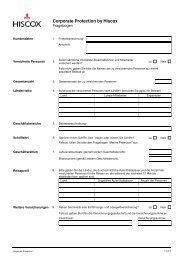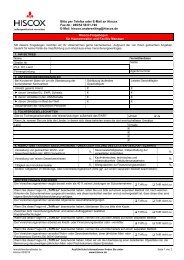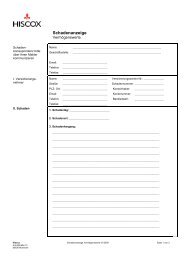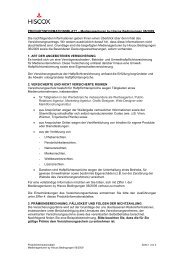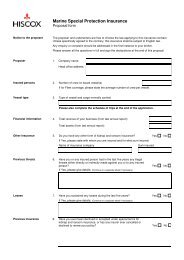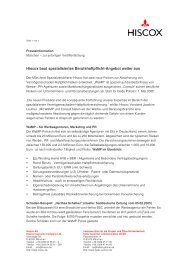Download PDF - Hiscox
Download PDF - Hiscox
Download PDF - Hiscox
You also want an ePaper? Increase the reach of your titles
YUMPU automatically turns print PDFs into web optimized ePapers that Google loves.
3 Management of risk continued<br />
3.1 Insurance risk continued<br />
Consequently the frequency and severity<br />
of reinsurance inwards claims is related not<br />
only to the number of significant insured<br />
events that occur but also to their individual<br />
magnitude. If numerous catastrophes<br />
occurred in any one year but the cedant’s<br />
individual loss on each was below the<br />
minimum stated, then the Group would<br />
have no liability under such contracts.<br />
Maximum gross line sizes and aggregate<br />
exposures are set for each type of programme.<br />
Property risks – marine and major assets<br />
The Group directly underwrites a diverse<br />
range of property risks. The risk profile of<br />
the property covered under marine and<br />
major asset policies is different to that<br />
typically contained in the other classes of<br />
property (such as private households and<br />
contents insurance) covered by the Group.<br />
Typical property covered by marine and<br />
other major property contracts include<br />
fixed and moveable assets such as ships<br />
and other vessels, cargo in transit, energy<br />
platforms and installations, pipelines,<br />
other subsea assets, satellites, commercial<br />
buildings and industrial plants and machinery.<br />
These assets are typically exposed to a<br />
blend of catastrophic and other large loss<br />
events and attritional claims arising from<br />
conventional hazards such as collision,<br />
flooding, fire and theft. Climatic changes<br />
may give rise to more frequent and severe<br />
extreme weather events (for example<br />
earthquakes, windstorms and river flooding<br />
etc.) and it may be expected that their<br />
frequency will increase over time.<br />
For this reason the Group accepts major<br />
property insurance risks for periods of<br />
mainly one year so that each contract<br />
can be re-priced on renewal to reflect<br />
the continually evolving risk profile. The<br />
most significant risks covered for periods<br />
exceeding one year are certain specialist<br />
lines such as marine and offshore<br />
construction projects which can typically<br />
have building and assembling periods<br />
of between three and four years. These<br />
form a small proportion of the Group’s<br />
overall portfolio.<br />
Marine and major property contracts<br />
are normally underwritten by reference<br />
to the commercial replacement value of<br />
the property covered. The cost of repairing<br />
or rebuilding assets, of replacement or<br />
indemnity for contents and time taken<br />
to restart or resume operations to original<br />
levels for business interruption losses are<br />
the key factors that influence the level of<br />
claims under these policies. The Group’s<br />
exposure to commodity price risk in relation<br />
to insurance contracts is very limited,<br />
given the controlled extent of business<br />
interruption cover offered in the areas<br />
prone to losses of asset production.<br />
Other property risks<br />
The Group provides home and contents<br />
insurance, together with cover for art<br />
work, antiques, classic cars, jewellery,<br />
collectables and other assets typically<br />
held by affluent individuals. The Group<br />
also extends cover to reimburse certain<br />
policyholders when named insureds or<br />
insured assets are seized for kidnap and<br />
a ransom demand is subsequently met.<br />
Events which can generate claims on these<br />
contracts include burglary, kidnap, seizure<br />
of assets, acts of vandalism, fires, flooding<br />
and storm damage. Losses on most<br />
classes can be predicted with a greater<br />
degree of certainty as there is a rich history<br />
of actual loss experience data and the<br />
locations of the assets covered, and the<br />
individual levels of security taken by<br />
owners are relatively static from one year<br />
to the next. The losses associated with<br />
these contracts tend to be of a higher<br />
frequency and lower severity than the<br />
marine and other major property assets<br />
covered above.<br />
The Group’s home and contents insurance<br />
contracts are exposed to weather and<br />
climatic risks such as floods and windstorms<br />
and their consequences. As outlined earlier<br />
the frequency and severity of these losses<br />
do not lend themselves to accurate<br />
prediction over the short-term. Contract<br />
periods are therefore not normally more<br />
than one year at a time to enable risks<br />
to be regularly re-priced.<br />
Contracts are underwritten by reference<br />
to the commercial replacement value of<br />
the properties and contents insured, and<br />
claims payment limits are always included<br />
to cap the amount payable on occurrence<br />
of the insured event.<br />
Casualty insurance risks<br />
The casualty underwriting strategy<br />
attempts to ensure that the underwritten<br />
risks are well diversified in terms of type<br />
and amount of potential hazard, industry<br />
and geography. However, the Group’s<br />
exposure is more focused towards marine<br />
and professional and technological liability<br />
risks rather than human bodily injury risks,<br />
which are only accepted under limited<br />
circumstances. Claims typically arise from<br />
incidents such as errors and omissions<br />
attributed to the insured, professional<br />
negligence and specific losses suffered<br />
as a result of electronic or technological<br />
failure of software products and websites.<br />
The provision of insurance to cover<br />
allegations made against individuals acting<br />
in the course of fiduciary or managerial<br />
responsibilities, including directors’ and<br />
officers’ insurance, is one example of<br />
a casualty insurance risk. However the<br />
Group’s specific exposure to this specific<br />
risk category is relatively limited. The<br />
Group’s casualty insurance contracts mainly<br />
experience low severity attritional losses.<br />
The Group’s pricing strategy for casualty<br />
insurance policies is typically based upon<br />
historical claim frequencies and average<br />
claim severities, adjusted for inflation<br />
and extrapolated forwards to incorporate<br />
projected changes in claims patterns.<br />
In determining the price of each policy<br />
an allowance is also made for acquisition<br />
and administration expenses, reinsurance<br />
costs, investment returns and the Group’s<br />
cost of capital.<br />
Sources of uncertainty in the estimation<br />
of future claim payments<br />
The Group’s procedures for estimating the<br />
outstanding costs of settling insured losses<br />
at the balance sheet date, including those<br />
not yet notified by, or apparent to, the<br />
insured, are detailed in note 27.<br />
The majority of the Group’s insurance risks<br />
are short tail and, based on past history,<br />
significant claims are normally notified<br />
and settled within 12 to 24 months of the<br />
insured event occurring. Those claims<br />
taking the longest time to develop and<br />
settle typically relate to casualty risks where<br />
legal complexities occasionally develop<br />
regarding the insured’s alleged omissions<br />
or negligence. The length of time required<br />
to obtain definitive legal judgements and<br />
make eventual settlements exposes the<br />
Group to a degree of reserving risk in an<br />
inflationary environment.<br />
The majority of the Group’s casualty<br />
exposures are written on a claims made<br />
basis. However the final quantum of these<br />
claims may not be established for a number<br />
of years after the event. Consequently<br />
a significant proportion of the casualty<br />
insurance amounts reserved on the balance<br />
sheet may not be expected to settle within<br />
24 months of the balance sheet date.<br />
Certain marine and property insurance<br />
contracts such as those relating to subsea<br />
and other energy assets, and the related<br />
business interruption risks, can also take<br />
longer than normal to settle. This is because<br />
of the length of time required for detailed<br />
subsea surveys to be carried out and<br />
damage assessments agreed together with<br />
difficulties in predicting when the assets<br />
can be brought back into full production.<br />
Notes to the consolidated financial statements <strong>Hiscox</strong> Ltd Report and Accounts 2009<br />
63




